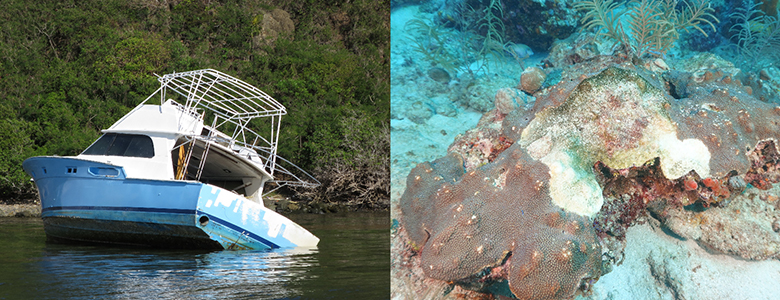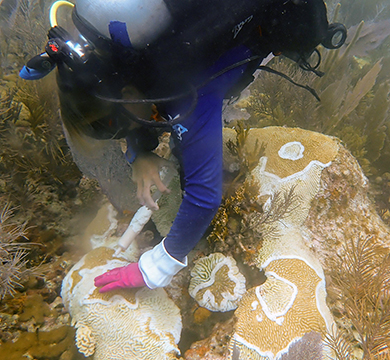- ABOUT US
- PROGRAM AREAS
- CONSERVATION APPROACH
- EDUCATION
- MULTIMEDIA
- Neely KL, Shea CP, Macaulay KA, Hower EK, Dobler MA (2021) Short- and Long-Term Effectiveness of Coral Disease Treatments. Frontiers in Marine Science 8 https://www.frontiersin.org/articles/10.3389/fmars.2021.675349/full
- Restoring corals after physical damage from vessel groundings and natural disasters
- Coral Heroes: The National Fish and Wildlife Foundation
- CRCP NOS Fiscal Year 2021: Year In Review
- CRCP Funding Opportunities
- Emergency Expedition Saves Thousands of Diseased Corals in Florida's Dry Tortugas National Park
Rapid response to coral emergencies requires a novel funding source
Coral reef conservation requires a multi-pronged approach from protection of pristine coral areas to restoration of significantly degraded areas. As part of their approach, coral managers need to have the ability to respond quickly to a disaster, be it natural or man-made. Hurricane relief funds and resources to respond to ship groundings come to mind. One very clear stressor that needs emergency help is coral disease, specifically Stony Coral Tissue Loss Disease in Florida and the Caribbean. Similar to treating cancer, it's better to be proactive in the early stages than wait until death is imminent. And, while that may sound serious, we are talking about life or death to the coral species that are succumbing to this disease.

To address this, and other dire circumstances, the Coral Emergency Response Fund was created. A partnership between NOAA and the National Fish and Wildlife Foundation (NFWF), the fund provides grants to rapidly respond to damage, disease, and stressors to corals and coral reefs that could not otherwise have been reasonably anticipated or avoided. This funding program is the first of its kind and allows NOAA and NFWF to respond to emergency events far more quickly than a traditional grant program can, enabling prompt damage assessment, triage, and initial response actions. Having a source of funding coral managers can quickly access to respond to a disaster, along with longer-term initiatives, means we are better positioned to protect and restore coral reefs.
Intervention of Stony Coral Tissue Loss Disease in Dry Tortugas, Florida
Since 2014, Florida has been combating an outbreak of the communicable, waterborne disease called stony coral tissue loss disease. However, application of an antibacterial treatment significantly decreases mortality of affected corals (Neely et al. 2021). Stony coral tissue loss disease arrived in the Dry Tortugas National Park, the most southern area of the state of Florida, in late spring 2021. In September 2021, the Coral Emergency Response Funds were used to finance a liveaboard intervention cruise that focused on a priority reef within the park named Bird Key Reef. This targeted intervention approach was highly successful in covering over 780,000 square meters of reef and treating 6,038 affected corals. In 2022, the funds were used again. Through these efforts, divers covered 107,556 square meters of reef at Loggerhead Key, as well as 1,861 square meters of reef around Garden Key. A total of 6483 corals with active SCTLD were treated.

The efficiency of corals treated in these emergency field sessions far exceeded expectations or any previous treatment work conducted in Florida. On average, each diver treated a coral every three minutes; on some dives, a diver averaged a coral every 90 seconds. By focusing all efforts on intervention, rather than data collection, photography, tagging/mapping, or monitoring, we were able to treat more corals in 9 treatment days than had been treated throughout Florida in nearly 2.5 years of treatment work (4813 corals in Florida through August 2021; Neely et al. 2021).

Coral rescue in the U.S. Virgin Islands
Broadly speaking, coral rescue means collecting a variety of coral species from the wild and holding them in land-based facilities to save and expand their genetic diversity. The Coral Emergency Response fund was used to support the protection and restoration of critical coral species in the U.S. Virgin Islands. A land based flow-through aquarium system is currently being expanded and upgraded for the specific purpose of rehabilitation and propagation of rescued corals affected by stony coral tissue loss disease. Coral genotypes identified as resistant to SCTLD will then be out-planted in local waters.

Conclusion
Other emergencies that have benefited from the fund include restoring corals after vessel groundings in Puerto Rico and successful rescue and transplanting of live coral days before a dredging operation was to commence, in Honolulu, Hawai'i. Despite our best efforts to protect corals, situations arise where coral managers need to quickly intervene to rescue damaged coral heads, stabilize reef structures, or respond to an outbreak of disease or influx of harmful invasive species like crown-of-thorns starfish. Emergency response and triage of corals paves the way for future restoration and recovery of damaged reefs. The creation of the Coral Emergency Response Fund with NFWF has given NOAA's Coral Reef Conservation Program and its partners a much needed conservation tool that prevents additional loss of corals in a disaster situation.
Publications
Related Stories and Products
About Us

The NOAA Coral Reef Conservation Program was established in 2000 by the Coral Reef Conservation Act. Headquartered in Silver Spring, Maryland, the program is part of NOAA's Office for Coastal Management.

The Coral Reef Information System (CoRIS) is the program's information portal that provides access to NOAA coral reef data and products.
Work With US
U.S. Coral Reef Task Force
Funding Opportunities
Employment
Fellowship Program
Contracting Assistance
Graphic Identifier
Featured Stories Archive

Access the archive of featured stories here...
Feedback
Thank you for visiting NOAA’s Coral Reef Conservation Program online. Please take our website satisfaction survey. We welcome your ideas, comments, and feedback. Questions? Email coralreef@noaa.gov.
Stay Connected
Contact Us
NOAA’s Coral Reef Conservation Program
SSMC4, 10th Floor
1305 East West Highway
Silver Spring, MD 20910
coralreef@noaa.gov
